
The name of Steed may be new to you. Currently run by Edwin De Boise, it was originally a partnership between two men. Edwin, who comes from a family of tailors and who had worked under the legendary Edward Sexton, met Thomas Mahon when he worked at Savile Row's Anderson and Sheppard as a cutter. The two of them struck off on their own to start Steed, and when Mahon left to pursue other things, including, eventually, his own firm and blog, English Cut, Edwin stayed on and is now training his son, Matthew, in the craft. The dinner suit which comes to me from London dates from the year 2000, a time when the two cutters were still together.
I'm not sure what I was expecting to find on opening the parcel, but given that I have been underwhelmed at best by what I have been looking at lately, my expectations were not high. Granted, the Steed garments I have seen in photos on the internet appear to fit well, however, photos of any sort are not always the best indicator of either fit or quality. In any case, we are starting to have an interesting sampling of garments- we have looked at a moderately-priced dinner suit from Samuelsohn, a more expensive dinner jacket from Brioni, and now a Dinner suit from a Savile Row craftsman. We also have garments from the 3 biggest names on Savile Row and now one of the smaller guys.
This suit is a one-button, peak lapel with grosgrain facing and side vents, and a double-pleated trouser with side adjusters. There is no separate side body, no front dart, and only a small underarm dart. Despite this, there is a decent amount of shape. The lining colour is actually the purple shown in the scan of the label- my lights turn the lining a pinkish shade when photographing. The trouser and the coat were let out by an alteration tailor who did a crummy job, so a few details will have to be ignored- I think it's safe to assume that, instead of sending the suit back to Cumbria for alterations, the owner had someone local do it.
One of the first thing I noticed (and have noticed on Steed's suits before) was the buttonholes. Not only are they individually well-executed, but getting them all lined up evenly is sometimes a challenge. Readers may recall the Huntsman suit which was nowhere near as well done. Upon closer inspection I noticed that the buttonholes had been sealed with some sort of gummy substance; it is common to seal them after cutting and before working them with beeswax- this helps prevent fraying and gives a more solid edge to work with, though it doesn't always work. Instead of using wax, it appears some sort of rubber cement has been used; whatever the case, if this is the result, I am all for it.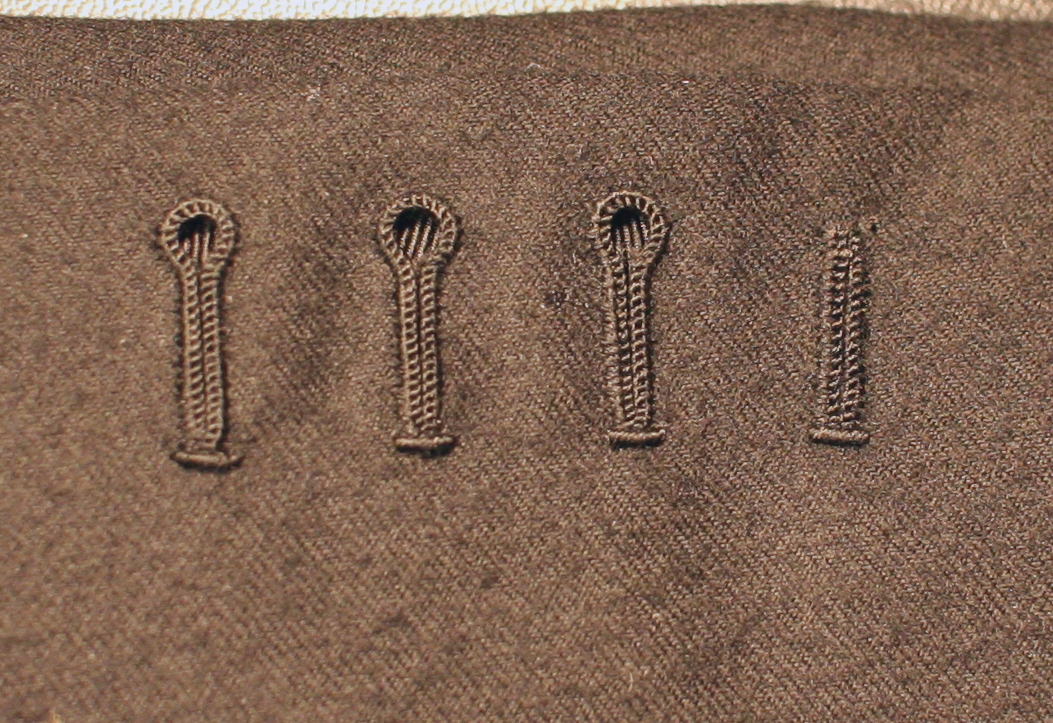
Another thing that is immediately apparent is the neatness of the trousers. Remember these, from legendary Anderson & Sheppard?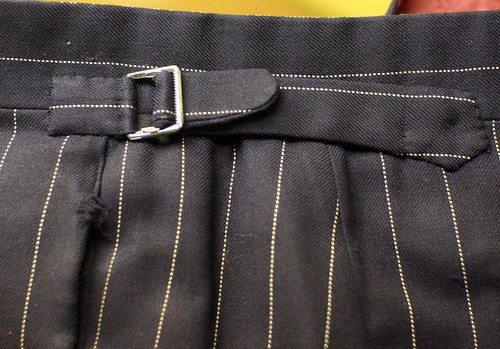
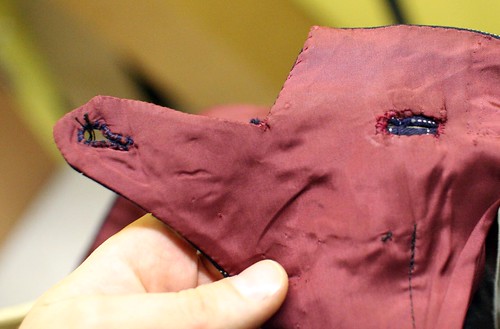
How much neater are Steed's trousers....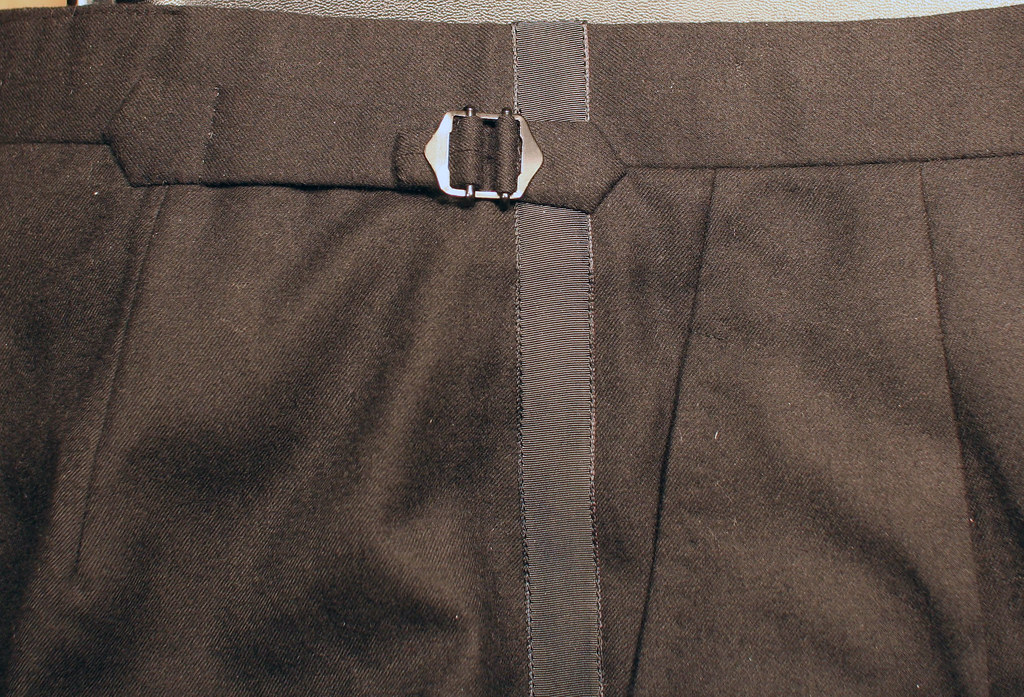
There is no knee lining in the trouser, like the A&S suit; the finishing of the inside is much neater. The pocketing could stop bullets, but if you lived in a high-crime area that might be a good thing. On the whole, I am impressed wit the trousers, the alteration job notwithstanding.
Oddly, the jacket seems to have taken more wear than the trousers; the cloth is showing some signs of pilling, which is one of the hazards of milled-finish cloths (the ones with a slightly fuzzy texture). While softer to wear and more resistant to shine from pressing than clear-finished cloth. I don't think it would be noticeable to any but the most observant or anal (are you reading this, Louche?) but it's something to consider when selecting cloth if you intend to get many years of wear out of your suit.
The interior pockets are constructed differently than the ones we are used to seeing from Row tailors, and they are neater. They are not anchored on a cloth extension, but this is to be expected when using grosgrain, which is too bulky for it. It's also the first time I have seen a tab closure on an inside pocket from Row tailors.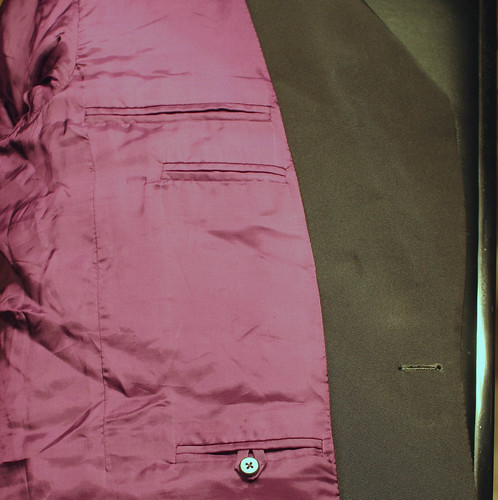
I won't bore you with all the details of it, but the facing construction is clever. Flannel is required on dinner suits to prevent the interior construction leaving impressions on the delicate silk and there are several ways to attach it. In this case, the flannel was assembled with the lining and machined onto the front as though it were a facing, which can make for a smoother edge, the flannel was basted onto the canvas with a few rows of stitches so it wouldn't shift, and then the silk was felled by hand over top of the flannel. 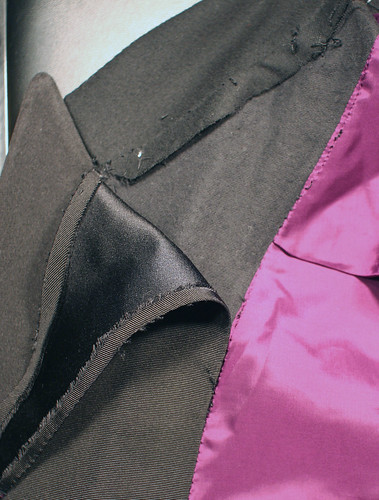
The finishing of the inside of the jacket is generally as neat as the trouser; comparable, I would say, to the Poole coat, and far better than the A&S.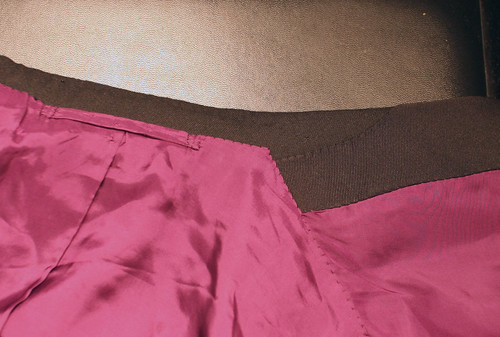
The canvas, of course, is constructed by hand, using a fine hair canvas. The chest has a full piece of haircloth, but a softer one than we often find in more constructed garments. Since both cutters were A&S alumni, I expected a chest construction like the A&S, in which the haircloth was cut away from the armhole, allowing the draped fold to form, but the canvas goes right into the armhole. With Edwin's varied experience, one can imagine he is able to give his customers what they want whether it is very soft and drapy or slightly more structured. The proportions of the garment do not suggest any great amount of drape either.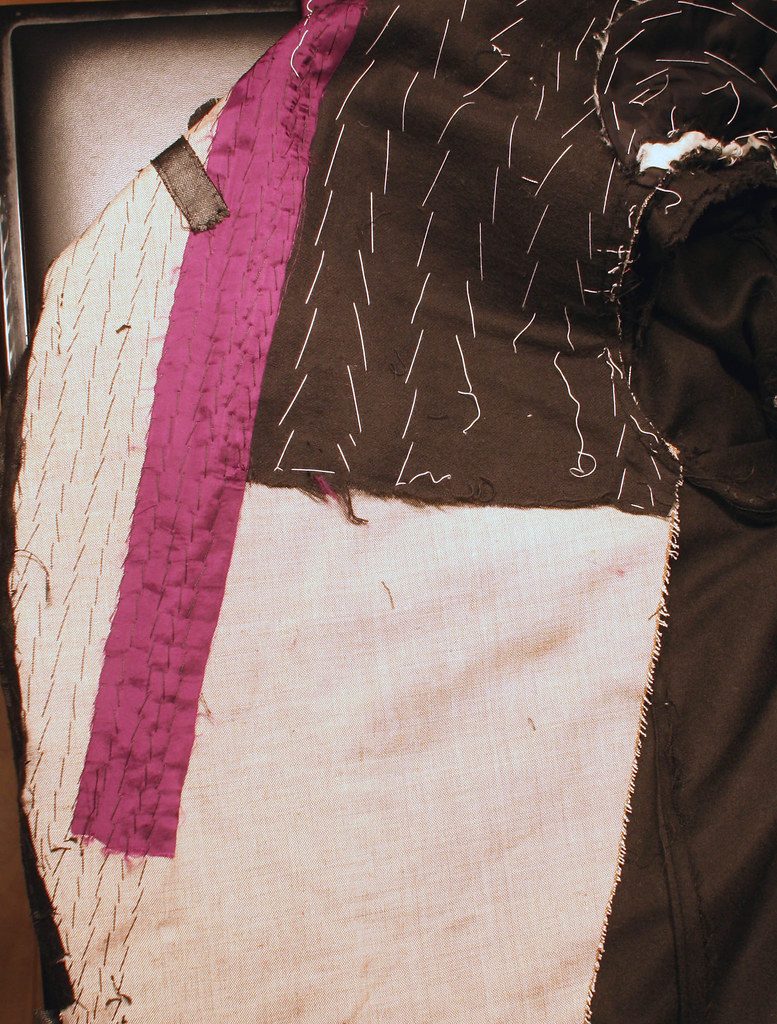
The sleeve has two layers of the same flannel as is used on the chest and to face the grosgrain (readers will remember than Huntsman uses four layers) and the shoulder has one small layer of wadding finished with lining, in the same manner as A&S, giving a very soft shoulder.
On the hand-sewing debate, the shoulder seam and sleeve setting were done by machine. Not that I think this is a minus, in fact, recent experiments have debunked some of the claims about hand-sewn seams. One thing I think we are mostly in agreement about, though, is that the armhole should be hand-finished, if not hand-sewn. This means the wadding, canvas and lining are all affixed by hand. In this case, however, the sleeve lining was affixed to the body lining by machine and was loose in the armhole; not only is this very curious, it is also not typical- the photos of recent Steed garments clearly show hand-finished armholes.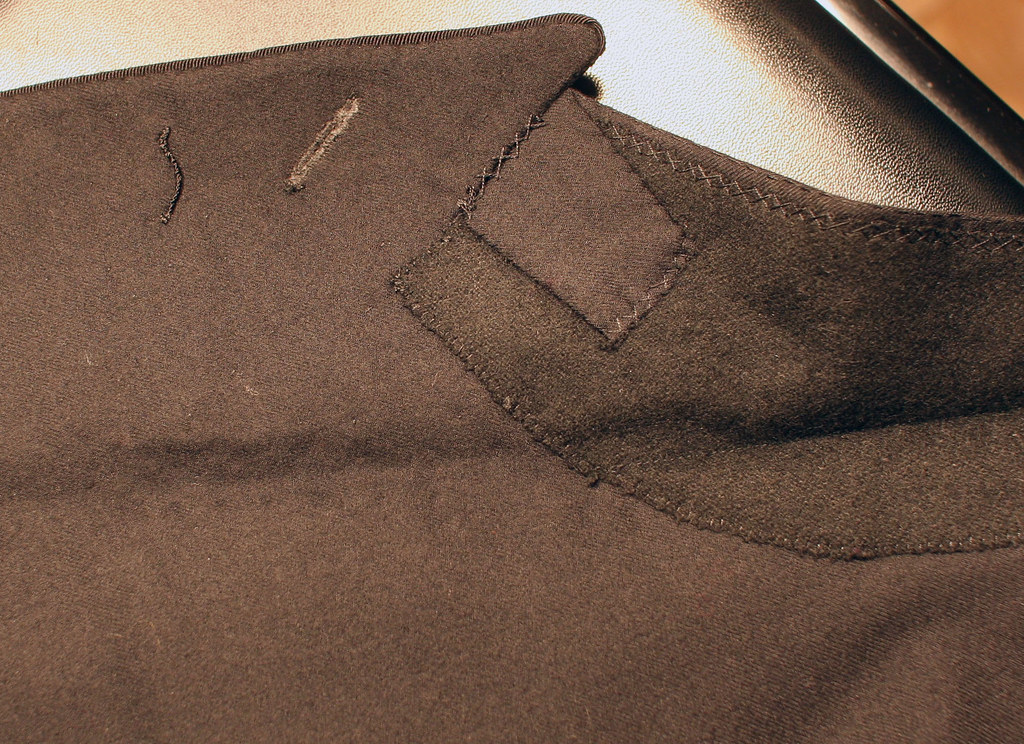
Though we might reasonably expect the general quality level to be lower from smaller firms than from the big Savile Row names, especially given the lower prices, this, clearly, is not the case. Maybe they feel they have to work that much harder in order to gain respect and recognition.
Whatever the reason is, it's good.








15 comments:
While some of the larger firms on Savile Row may have more money to spend on advertising and publicists who will place an article in print, albeit to shore-up the reputation of a well-known name in bespoke tailoring, it's no guarantee that the garments will be any better than those produced by a smaller firm on or off the row. In my experience smaller is preferable to the biggies. Less espensive, too. Personal attention, the skill and artistry of cutters, tailors, seamstresses and pressers, however few they may be in a small firm, may very well trump their larger counterparts who all to often resort to mentioning the names of royalty, actors, captains of industry and indolent trustfund twits tailored by them in bygone eras. It leaves a fellow embarking on a commission underwhelmed and insulted. Find a good tailor who focuses on you, and nobody else but you!
JMB
Your blog and commentaries are of great value. Please keep up the good work.
Hi, I've loved reading your blog for a long time, I get more and more fascinated with each new post. You had a side comment in this one that caught my attention in a way that I might be able to help. Regarding the problem you described, where "my lights turn the lining a pinkish shade when photographing." In truth, and looking at these other photos, it's more likely your camera than your lights. As you can see, the black of the dinner suit is showing up as an almost grey-brown almost dark taupe rather than a deep black (i didn't even realize the photo WAS a dinner suit at first.. i thought "who buys a taupe dinner suit?") Have you played at all with the "white balance" setting on your camera? You may need to read the manual a bit, but most digital cameras have the ability to take a photo of a white object (or piece of paper) before you start shooting, to give a reference point of what is actually white under your lighting conditions. This has a profound effect on the colors of the resulting photos. I hope this helps! Please keep on doing what you're doing!!
Great post, Jeff. Louche was indeed reading. Please keep up the bits on fabric and the wise selection of it. Regards.
- Louche
Thanks, Leigh & Louche
I have an admission to make- I actually have one of those cards with white, black and 18% grey zones so there is no reason other than my laziness for not adjusting the white balance. Maybe now that I know that people who know what they are seeing are looking, I might put a little more effort into my shots! :)
J
You are really amazing. I will definitely be following you for now on. By the way, Fatto can you recommend where I could buy a great book that teaches how to draft patterns for Men's Sport Coats? It would be greatly appreciate.
mysocietynewyork.com
Thank you, Terry
Sadly, there are no good, modern books in English to be had, however some of the Rundschau publications have been translated into English. I suggest you check out this forum which has a bibliography and suggestions for books
http://www.cutterandtailor.com/forum/index.php?showforum=25
best
J
Thank you, I really appreciate your help. I will continue to follow your site, it's really awesome.
Best Regards
Terry
Nice post
I've been noticing on both bespoke and RTW garments, Peak lapels will have some stitching connecting to the collar. What is the purpose, and is it supposed to remain, or be removed (like the stitches closing a pocket)?
Yes, it is supposed to remain- it helps to keep the point of the peak flat and tight to the collar.
I have an MTM suit from Steeds - about a year old. It fits perfectly and wears well, no creases even after 2 days of constant use. I'm not sure Bespoke would have been worth the extra money. I highly recommend them.
I emailed Steed last year about the armhole and shoulder seam finishing and sewing and they told me that for many years, that’s been done by hand by all of their tailors. It was always done by hand by their older tailors and originally done by machine by the younger tailors.
Contrary to what I said yesterday, when I exchanged emails with Steed last year, they told me that all of their hand made bespoke garments are completely hand finished (including the armholes and shoulders of coats) by all of their tailors. Steed also told me that if there's any machine finishing in their hand made bespoke garments, it's only because their clients took their garments to offsite alterations tailors to be altered and are otherwise completely hand finished. For what it's worth, Steed strongly recommends that all of their garments are altered by nobody other than Steed themselves.
Of course, as I said yesterday, when I exchanged emails with Steed last year, they told me that the setting of the coat sleeves and stitching of the coat shoulders has always been done by hand by their older tailors and, for many years now, by their younger tailors (who, again, originally set the coat sleeves and stitched the coat shoulders by machine).
The only machine work in Steed's hand made bespoke garments is two layers of black solid cotton flannel fabric being stitched between two layers of lining fabric (this stitching is done by machine in some areas and by hand in others). These layers of fabric are stitched together before being stitched to the garment then stitched to the garment entirely by hand. All of this is what I was told in our email exchanges last year.
When I spoke to Steed via email last year, they told me they are one of the minority of English tailors (Savile Row and otherwise) that have the quality and quantity of hand stitching and overall quality of French and Japanese tailors along with never outsourcing any of the work that they do to anybody, being it hand made bespoke or alterations, just like the French and Japanese. The reason they are priced lower than most Savile Row tailors is because their supply is always a little higher than their demand (though both are high) and their workshop is in Cumbria (which is a wealthy rural town in northern England; their shop for fittings in on Savile Row in London). Cumbria has far lower insurance and rent costs that any part of London (especially Savile Row and Jermyn Street).
Plus, Steed relies a lot less on advertising and has more simplified offerings than most Savile Row tailors. There's no ready to wear and the only garments that they make are for casual dress, dress and formal (mostly the latter two and they don't make duffle coats, pea coats and trench coats).
They don't do women's clothing either. But that's only because no women or far too few women have clamored for clothing from Steed in the 23 years they've been in business.
Post a Comment